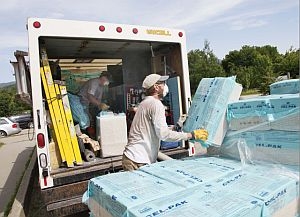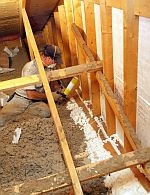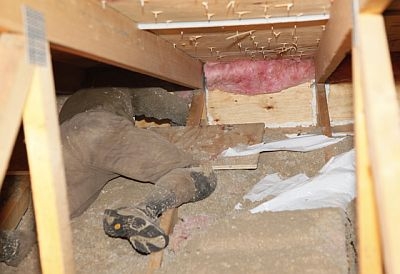
(Host) Over the weekend, a group of volunteers in central Vermont got caked with dust and sweat as they worked to make an elementary school more energy efficient.
The project will cut fuel oil use by about 30 percent. The work also provides a hands-on lesson for the community on how to save energy in homes and public buildings.
VPR’s John Dillon has this report:
(Dillon) A forklift stacks pallets of cellulose insulation. The stuff is made from old newspapers, and it’s the raw material for a major energy retrofit here at the Rumney Memorial School in Middlesex.
The other key ingredient is a team of volunteers who’ve assembled to seal the nooks and crannies in the attic. They’re plugging air leaks where heat escapes in the winter, wasting fuel oil and tax dollars.
 (Rosen) "By using volunteer labor we’re doing for $10,000 what might cost three times that."
(Rosen) "By using volunteer labor we’re doing for $10,000 what might cost three times that."
(Dillon) Adam Rosen is Rumney’s principal. He’s hoping the insulation work will cut the school’s fuel bill by several thousand dollars a year.
(Rosen) "This building historically has used between like 8,500 gallons, and one year recently it was actually a little over 10,000 gallons. I cross my fingers and we had Irving Oil bid 6,500 gallons for next year…. So that’s $2,500 maybe $4,000 this year. Multiply that by year after year after year."
(Dillon) Inside the school’s gym, energy efficiency expert Paul Zabriskie huddles with a work crew and sketches out the day’s plan of attack.
(Zabriskie) "So, we’re going to close that off and get some R-value on all this masonry, which is essentially directly connected to the outside. And it’s hard hat territory, there’s nails stuck through this roofing right here. So you’re in a spot where you’re banging your head. Everyone will get a taste of the discomfort of this work. But with this many people, it will go fast."
(Dillon) A few minutes later, Zabriskie emerges from an attic crawl space covered in cellulose dust. He explains how the Rumney energy retrofit project got started.

(Zabriskie) "We were brainstorming, ‘How do we help the larger community understand how their houses work and some of the things that people can do in their own home.’ And we essentially came down to the fact that we need teaching opportunities."
(Dillon) Zabriskie is a member of the town’s energy committee. In his day job, he’s general manager of an organization called EnergySmart, which does energy audits and efficiency renovations.
Zabriskie says the Rumney school is built like many Vermont houses – just on a bigger scale .
(Zabriskie) "It’s sort of one school, but in fact there’s nine or ten generations of construction, not unlike a traditional cape that had a shed that began as a kitchen and so on and so on. Mostly wood frame structure. So what we find in this building is very typical to what most of our homes look like."
(Dillon) And like many Vermont houses, Rumney School was built to the energy standards of the day. Ceilings were typically insulated with fiberglass insulation that fails to block air from moving through. The volunteers are methodically plugging leaks and getting the attics ready for cellulose to be blown in.
It’s hot, grimy work. Town resident Elliot Burg has insulation stuck to his arms and his face is streaked with sweat.
(Burg) "We’ve been foam-sealing and peeling back fiberglass insulation so the guys can come in and put cellulose in. It’s going to reduce the fuel usage tremendously here, and I think our savings on carbon emissions are about 22 tons a year – which for a tiny community is great."
(Dillon) Burg says the project will not only cut back on greenhouse gases, but it will also show residents how they can improve their own homes.
(Burg) "If tomorrow when we have our celebration here and barbecue that we can communicate to the community that this is the kind of initiative that people can undertake in their homes, in their lives, I think it will be worth it."
(Dillon) The Rumney project was funded by a climate change grant from the state Agency of Natural Resources.
For VPR News, I’m John Dillon in Middlesex.